How to build a carbon neutral economy for the United States by 2050
By Gordon McCord, Associate Teaching Professor and Associate Dean, School Of Global Policy And Strategy, University Of California, San Diego; Co-chair of SDSN USA and a member of the FABLE US team.
The Zero Carbon Action Plan (ZCAP), a project of the United Nations Sustainable Development Solutions Network (SDSN) USA, brings together policy experts to propose solutions that would put the US on a path towards deep decarbonisation by mid-century. ZCAP seeks to provide an action plan to inform federal policy makers, business leaders, and civil society more broadly across jurisdictions.
The ZCAP works in parallel with the Food, Agriculture, Biodiversity, Land Use and Energy (FABLE) Consortium, which proposes a set of sustainable land use pathways for the US that optimise trade-offs between production (including food and biofuels), conservation of natural ecosystems, and Green House Gas Emissions (GHG) targets. These sustainable land use pathways show how the US can achieve a +300% reduction in Agriculture, Forestry and Other Land Use (AFOLU) emissions by 2050, compared to the Current Trends pathway. ZCAP policy recommendations are guided by FABLE for land use, and by the Deep Decarbonization Pathways Project for the energy, transport and industrial sectors.

Today’s challenge
ZCAP shows that the US can achieve net zero GHG emissions by 2050 and offers a wide set of actions that are required for major energy-producing and energy consuming sectors, including land use for agriculture, forestry, and more.
While ZCAP focuses on the transformation in the energy, transport, and building sectors, it acknowledges that achieving net-zero GHG emissions for the US by 2050 will require multiple actions in the land use sector. Priority actions include building the necessary infrastructure for renewable energy production and transmission, addressing sustainability challenges emerging from the expected increase in the use of biofuels, reducing GHG emissions from agriculture and livestock production, and managing soils to increase carbon storage.
Afforestation, reforestation and better forest management can increase the carbon sink in US forests significantly. And healthier, more sustainable diets coupled with reduced food loss and waste, can lower pressure on land.
Sustainable land use must also accommodate urban areas and infrastructure, meet national commitments to water and biodiversity conservation and maintenance of ecosystem functions, and provide enough food to satisfy human needs for the US and global food trade.
From modeling to land use policies
Modeling pathways can help decision makers evaluate potential trade-offs and design policies that are economically efficient and environmentally friendly. Building on the results of modeling exercises for land use, ZCAP policy recommendations address the following:
- Developing renewable energy projects and expand transmission infrastructure for delivery of power from renewables.
- Financing incentives for ‘agrivoltaics’ and distributed generation, as well as renewables development, on existing structures on agricultural land and contaminated and underutilised sites.
- Regulations to address jurisdictional overlaps.
- Policies to assess impacts of renewable siting on communities.
- Development of a national reforestation goal by 2050, supported by various incentive policies and federal acquisition of private lands for reforestation where feasible and effective.
- Policies to increase carbon storage in agricultural soils built around incentives, monitoring, and reporting.
- Transformation to next-generation biofuels through increased RDD&D funding, a new low-carbon fuel standard, and new federal procurement standards.
- Dietary shifts to foster healthier diets produced by a food system with lower GHG emissions.
- Reduction of food loss and waste.

In addition, three overarching policy recommendations span the many issues that arise with respect to decarbonisation of the US economy and the role of US lands.
- ARPA-Land (Advanced Research Projects Agency): The ARPA labs have proven to be invaluable assets to US leadership in scientific discovery and the development of cutting-edge technologies. Given the range of technical challenges the US faces with regard to the role of its land in economy-wide decarbonisation, the government should create an ARPA lab with a singular focus on land based activities.
- New inter-agency task force on land: Authority over relevant land use activities spans multiple areas of the US government. It is critical that federal departments and agencies coordinate and align their priorities to manage trade-offs and maximise synergies in land use decisions. Such a task force should coordinate with relevant states, as these too have significant authority over land use decisions.
- Integrated Spatial Planning: Federal and state governments lack both long-term targets to achieve sustainable food and land use systems as well as pathways to achieve those targets. An important first step is to support the development of analytical tools to understand the complex synergies and trade-offs across these areas and to determine which short-term measures must be undertaken in order to achieve long-term objectives. The tools developed by FABLE integrate agronomy, nutrition, ecology, hydrology, climatology, and economics, offering an important foundation upon which to build integrated pathways to plan for sustainable land management.
Countries looking to achieve sustainable food and land use systems by mid-century will have to undertake a two-step approach, crafting short-term policies aligned with long-term success. The example of FABLE and ZCAP show how policy debates can move forward when built on evidence and integrated models across both area of focus and governance.
To learn more about land use recommendations of the ZCAP project, you can watch this video









